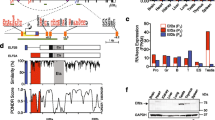Abstract
The TFPT/FB1 gene was identified because of its involvement in childhood pre-B acute lymphoblastic leukaemia (ALL). Although its specific function is still unclear, Tfpt has been implicated in cell proliferation and induction of programmed cell death (PCD). Given the critical role of PCD in leukemogenesis, we have investigated the responsiveness of different cell lines to TFPT over expression and the consequent induction of PCD by proliferation kinetic analysis, immunolocalization and TUNEL assay. We have also tested the involvement of factors implicated in cell cycle progression and apoptosis, i.e. caspases, p53, Cdc2.
Our results indicate that over expression of TFPT promotes caspase 9-dependent apoptosis, nevertheless the apoptotic cascade is engaged only in culture conditions sustaining cell proliferation and different cell lines display differential responsiveness to TFPT induced apoptosis Although p53 is a main regulator of apoptosis in mammalian cells, the Tfpt induced apoptosis appears p53-independent. These results are discussed relatively to the role played by TFPT in leukemogenesis.
Similar content being viewed by others
References
Brambillasca F, Mosna G, Colombo M et al (1999) Identification of a novel molecular partner of the E2A gene in childhood leukaemia. Leukemia 13:369–75
Brambillasca F, Mosna G, Ballabio E, Biondi A, Boulukos KE, Privitera E. (2001) Promoter analysis of TFPT (FB1), a molecular partner of TCF3 (E2A) in childhood Acute Lymphoblastic Leukemia. Biochem Biophys Res Commun 288:1250–257
Irie Y, Yamagata K, Gan Y et al (2000) Molecular cloning and characterization of Amida, a novel protein which interacts with a neuron-specific immediate early gene product Arc, contains novel nuclear localization signals and causes cell death in cultured cells. J Biol Chem 275:2647–653
Gan Y, Taira E, Irie Y, Fujimoto T, Miki N (2003) Arrest of cell cycle by Amida which is phosphorylated by Cdc2 kinase. Mol Cell Biochem 246:179–85
Wang DC, Chen SS, Lee YC, Chen TJ (2006) Amyloid-beta at sublethal level impairs BDNF-induced Arc expression in cortical neurons. Neurosci Lett 398:78–2
Chipuk JE, Green DR (2005) Do inducers of apoptosis trigger caspase-independent cell death? Nature Rev Mol Cell Biol 6:268–75
Dai X, Yamasaki K, Yang L et al (2004) Keratinocyte G2/M growth arrest by 1,25-dihydroxyvitamin D3 is caused by Cdc2 phophorylation through Wee1 and Myt1 regulation. J of Investigation Derm 122:1356–364
Okada H, Mak TW (2004) Pathways of apoptotic and non-apoptotic death in tumour cells. Nature Rev Cancer 4:592–03
Zhang X, Wharton W, Donovan M, Coppola D, Croxton R, Cress WD, Pledger WJ (2000) Density-dependent growth inhibition of fibroblasts ectopically expressing p27kip1. Mol Biol Cell 11:2117–130
Long H, Han H, Yang B, Wang Z (2003) Opposite cell density-dependence between spontaneous and oxidative stress-induced apoptosis in mouse fibroblast L-cells. Cell Physiol Biochem 13:401–14
Peller S, Rotter V (2003) TP53 in hematological cancer: low incidence of mutations with significant clinical relevance. Human Mutation 21:277–84
Lowe SW, Cepero E, Evan G (2004) Intrinsic tumour suppression. Nature 432:307–15
Boosen M, Vetterkind S, Koplin A, Illenberger S, Preuss U (2005) Par-4-mediated recruitment of Amida to the actin cytoskeleton leads to the induction of apoptosis. Exp Cell Res 311:177–91
Norbury CJ, Zhivotovsky B (2004) DNA damage-induced apoptosis. Oncogene 23:2797–808
Boehrer S, Chow KU, Puccetti E et al (2001) Deregulated expression of prostate apoptosis response gene-4 in less differentiated lymphocytes and inverse expressional pattern of par-4 and bcl-2 in acute lymphocytic leukaemia. Hematol J 2:103–07
Boehrer S, Chow KU, Beske F et al (2002) In lymphatic cells par-4 sensitizes to apoptosis by down-regulating bcl-2 and promoting disruption of mitochondrial membrane potential and caspase activation. Cancer Res 62:1768–775
Affar el B, Luke MP, Gay F et al (2006) Targeted ablation of Par-4 reveals a cell type-specific susceptibility to apoptosis-inducing agents. Cancer Res 66:3456–462
Author information
Authors and Affiliations
Corresponding author
Rights and permissions
About this article
Cite this article
Franchini, C., Fontana, F., Minuzzo, M. et al. Apoptosis promoted by up-regulation of TFPT (TCF3 fusion partner) appears p53 independent, cell type restricted and cell density influenced. Apoptosis 11, 2217–2224 (2006). https://doi.org/10.1007/s10495-006-0195-5
Published:
Issue Date:
DOI: https://doi.org/10.1007/s10495-006-0195-5




